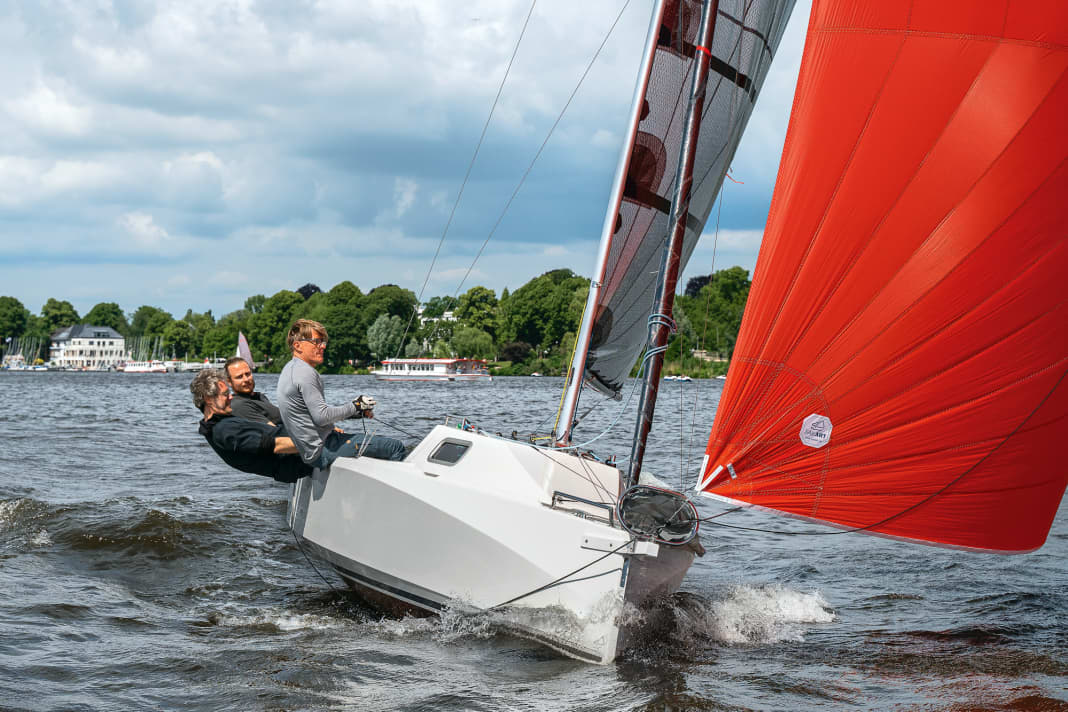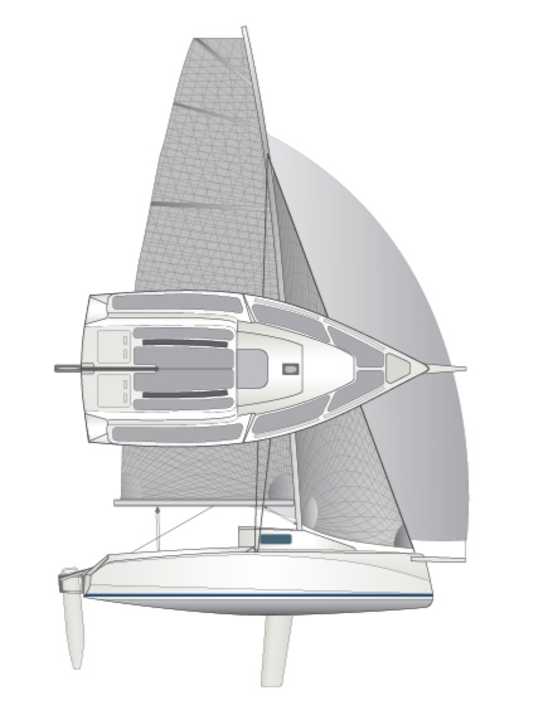





At first glance, the upward sloping chine of the Sailart 18 from the wave piercer bow looks very striking, almost aggressive. But Frank Störck, owner of the Sailart shipyard, counters this: his new boat is by no means a regatta boat, let alone a racer; on the contrary, the design was a deliberate departure from the micro-tonner design class. Nevertheless, the 18's sporty genes are clear to see - even if it is primarily intended to be a fast leisure craft rather than scoring points on the regatta course.
Störck is therefore unwilling to accept the obvious comparison with the competition, namely the Seascape and First 18. "Our boat is much more good-natured, almost toned down," he emphasises. There is neither a retractable gennaker pole - which makes handling the large cloth easier - nor is the sail type so brutally wide in the aft waterline - which improves light wind performance in particular when sailing upright thanks to less wetted surface area. "This also means that only one rudder blade is required," says Störck.
However, the moderate lines are noticeable on the water: The boat seems quite slender at first. As soon as the Chine dives in, it is very stable. Nevertheless, during the test, which took place in 12 to 15 knots and sometimes very strong gusts of well over 20 knots of wind, three people on the edge are not too few to ensure that the Sailart 18 remains controllable even in windy conditions and under gennaker. Thanks to the outhaul straps in the wide cockpit, the body weight can be brought well to windward. This creates a really sporty sailing feeling, just like on a dinghy. The only difference: the 130 kilos of ballast provide so much security that we can take out the gennaker without hesitation despite the gusts.
Full control over the Sailart 18
On an upwind course, the log climbs to just over 5 knots - which is already very good for a boat just 5.30 metres long. Under gennaker, however, it really gets down to business: 7 knots and more are easily achievable, provided that the coordination between the foresailor and helmsman is right, especially in the gusts. The front must be fished in good time and the back must be dropped quickly in order to actually convert the pressure into speed.
This is not always possible on Hamburg's rather small Outer Alster with its many training boats and stand-up paddlers, as it is not only important to find the ideal line for gennaker racing, but also not to run anyone over. But a few times it does work out. Then the Sailart starts to slip, then you can feel a slight buzzing in the boat, then the stern wave stays astern. The GPS shows just under 9 knots over ground - without us having utilised the full potential for even faster room sheets due to the lack of constant wind.
It's quick and easy to stow the gennaker in the optional recovery trumpet. With half the wind, we are now logging over 6 knots, and when we drop in a gust, we can even glide briefly with just the main and jib. On the cross, the 18 can be easily steered on the wind edge, the rudder gives good feedback without strong pressure.
Whether there is a lot or little wind, weight trim is important on the Sailart 18. As soon as the wind drops, at least the foresailor must be in the cockpit, otherwise the small boat will heel to windward. The ideal crew in light winds is two rather than three sailors.
Space wind rocket
The Sailart 18 has 20 square metres of sail area upwind (14 square metres in the main, six in the furling jib) - not a small amount considering the boat weighs just under half a tonne. The gennaker measures 25 square metres. So it's no wonder that the new boat accelerates so well on the beam, as the sail area almost doubles.
A nice detail on the headsail: the furling system is fitted below deck in the anchor locker. This means that the foot can be cut very low and the foresail also looks very tidy. Overall, however, the rig is kept rather simple. For example, the upper shrouds are guided by spreaders that sweep strongly aft, making a backstay superfluous. In any case, this would only get in the way of the mainsail, which is flared out at the head.
There is also a lower shroud on each side and, of course, the forestay. In addition to the halyards, there are three trimming devices - the downhaul, cunningham and outhaul - which are arranged around the companionway together with the fore sheets. The sheet angle can be changed using the 3D centreboard, which is attached to the superstructure and allows narrow angles. The carbon fibre boom, which is available as an option, does without fittings as far as possible. Instead, Dyneema shackles and lashings are used. Despite the simplicity of the boat, this shows that the shipyard has placed great emphasis on functionality. This also applies to the rudder system: the blade is mounted in a cassette so that it can be caught up, and it fits perfectly. There is no rattling to be heard and no spongy feeling when steering. And yet the rudder blade can be pulled upwards with a single movement if required.
There are also two stainless steel plates on both sides of the aft edge of the open stern. The swim ladder and motor bracket can be inserted into these. This is practical and does not get in the way if one or the other is not fitted. When underway, the ladder and engine can be stored in the very large locker in the stern. It is accessible via two watertight hatches in the cockpit floor and is two metres wide, over a metre long and around 35 centimetres high. However, too much equipment should not be stored in it, as too much weight in this area is likely to have a negative effect on the sailing characteristics.
Sailart 18 is unsinkable
The space under the forward section of the cockpit up to the small cabin is filled with epoxy foam, as is the bow section under the berth cushions. This means that the Sailart 18 remains on the surface even if it should fill up during an unsuccessful gennaker manoeuvre, for example. In addition, thanks to the arrangement of the two buoyancy chambers, it lies horizontally in the water and can be scooped up empty.
The bunk takes up almost all the space in the small cabin. At 200 by 161 centimetres at shoulder height, it is comfortable for two people, even though the boat is not designed for travelling on the water. It is certainly possible to spend a night or two on board. Especially as the superstructure windows can be opened and there is also storage space: Stowage bags can be attached to a piping rail on both sides of the deck-hull connection and positioned as required.
However, there is no headroom in the cabin. It is 126 centimetres high under the hatch in the footwell in front of the berth, with 79 centimetres of space above the berth. On the test boat, the battery, log and plumb bob are housed under the cushions to starboard. The cables to the instrument in the companionway bulkhead are neatly routed in a cable duct specially adapted to the shape of the bulkhead, which matches the topcoat of the interior - another example of the high-quality workmanship even in small details.
How much extra can I have?
In view of the quality of the boat builder, the price seems fair: the Sailart 18 costs 20,900 euros (incl. 19 per cent VAT) in its basic configuration. With extras like the test boat, i.e. superstructure window, carbon boom, laminate sails, furling system, gennaker, trumpet, electric package, outboard motor bracket and more, the price is 28570 euros. But it doesn't have to have that much additional equipment. With the gennaker, furling system and recovery trumpet alone, the Sailart 18 is a great leisure racer that should also provide fun and good placings at club regattas.
YACHT rating
The Sailart 18 is a very successful boat for leisure fun and club regattas with a high speed potential
Design and concept
- + High speed potential
- + Three people required on the edge in windy conditions
Sailing performance and trim
- + Boat starts very well
- + Gets off to a good glide
- + Well controllable; feedback from the rudder
Equipment and technology
- + Fathead large; no backstay
- + jib furler below deck
- + Gennaker trumpet simplified setting and recovery
Technical data
- Torso length:5,30 m
- Width:2,30 m
- Depth: 0,20-1,30 m
- Weight: 480 kg
- Ballast/proportion:130 kg/27 %
- Mainsail: 14,0 m²
- Fock: 6,0 m²
- Gennaker:25,0 m²
- Hull and deck construction: Deck and hull as a sandwich made of GRP with polyester resin and Divinycell foam core
- Base price ex shipyard*: 20900 €
- Price ready to sail*: 25240 €
- Shipyard:Sailart, Siemensstraße 8a, 50374 Erftstadt; www.sailart.de

* how the prices shown are defined can be found here !
Also interesting:
- Half dinghy, half small cruiser: Sailart expands its portfolio with the 17.5
- Small cruiser "Dopamine": All-rounder suitable for self-builders
This article appeared in YACHT in issue 18/2020.

